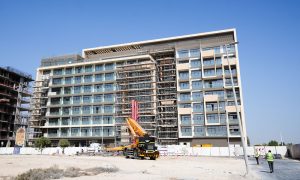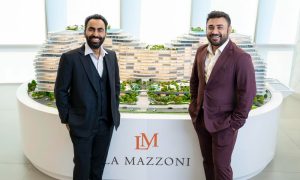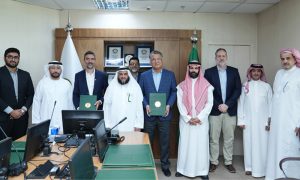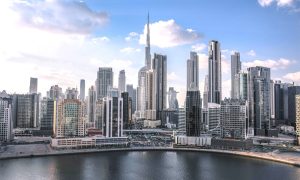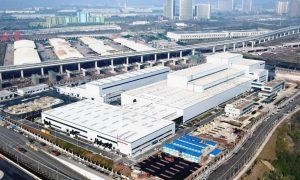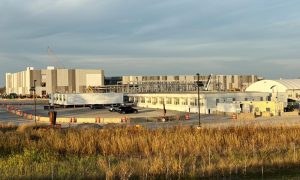The EC Way
ME Consultant visits EC Harris’ office in Dubai’s Emaar Square

Less than two minutes after arriving at EC Harris’ spacious Dubai office in Emaar Square, Middle East Consultant is alerted to the location of the nearest fire escape and the exact procedure to follow in the event of an alarm.
It is mandatory for all first-time visitors to receive a safety briefing, explains Tom Baines, head of health, safety and environment. He continues: “From the very moment somebody comes to our business, our focus on health and safety is embedded into them. Every visitor gets a briefing.”
This procedure is an unusual greeting to an office – especially in a region where safety often falls by the wayside – yet EC Harris is far from a typical construction consultancy. Formed in 1911 in the UK by Edward Charles Harris, the firm made a name for itself as a quantity surveyor, primarily in commercial property.
Having grown in size and scope over the last few decades, EC Harris merged with Holland-based Arcadis in November 2011, growing its available workforce to 22,000 worldwide. Currently EC Harris is branded as a built asset consultancy which is part of the Arcadis Group. It has about 600 people across the region, with offices in Dubai, Abu Dhabi, Doha, Muscat and Jeddah.
According to Middle East CEO John Williams, a lot of misconceptions arise from the company’s past. He explains:
“There is a common held myth that EC Harris is a quantity surveying firm that focuses on commercial property. I can understand that because its roots are over 100 years old. For the last 30-40 years we’ve steadily become much more multidisciplinary. We are a much broader business, but the legacy is there which people will find difficult to shake off.”
After the Arcadis merger, EC Harris realigned its focus into four global business lines: water, environments, infrastructure and property. “Arcadis has been globally recognised in sectors that maybe EC Harris are lesser known in,” continues Williams.
“For example, Arcadis manages the New York City water department. There are areas of deep knowledge and content that have come to EC Harris. It is bringing new skillsets and market opportunities to the business, in areas where people might not have seen us in the past.”
Tim Risbridger, partner in the infrastructure sector – Middle East, adds: “One of the objectives of our marketing over the last few years has been to educate some of our clients, and the broader market, that we aren’t just doing project management and quantity surveying, in the property sector. The biggest thing, for me, is becoming part of Arcadis. Previously we had some success in areas like ports and highways, but we hadn’t been able to accelerate – now we have over 100 people working in infrastructure in the region and it creates the critical mass.”
Another key capability accrued from the merger was engineering. “That was the single biggest issue which was holding us back in the infrastructure sector,” continues Risbridger. “We couldn’t ever sell ourselves as engineers. As an organisation we were not prepared to take design liability, in any contract. Since the merger with Arcadis that changed instantly and has opened a whole new field of opportunities to us.”
The engineering capabilities of Arcadis, and in turn EC Harris, could be further boosted by the proposed acquisition of Hyder Consulting, one of the world’s top engineering firms.
Terry Tommason, partner and head of property and infrastructure – Middle East, explains that a large chunk of EC Harris’ work in the Middle East is programme and project management for signature projects. “We’re not necessarily the quantity surveyor in these projects,” adds Tommason.
The company has landed consultancy work on several of Qatar’s major programmes, including the Santiago Calatrava designed
Sharq crossing, a series of bridges and tunnels that link Doha’s new airport with the city and Lusail. “It’s arguably the most prestigious piece of infrastructure anywhere in the world right now,” says Tommason.
He continues: “We are doing the largest phase of Doha Metro in conjunction with Jacobs as programme managers – that’s more than 100km of below ground and elevated section of metro. We’ve just delivered Hamad Medical City as programme managers – the second largest hospital in the world – which is quite extraordinary in scale.”
In a joint venture with Mace, EC Harris is developing a framework with Ashghal – Qatar’s public works authority – to deliver its building affairs portfolio, an eclectic collection of education, ports, zoos and healthcare projects. “That may be the largest programme of buildings is the world at the moment. It is enormous,” says Tommason.
Perhaps the company’s most high profile scheme is the world’s tallest building, Kingdom Tower in Jeddah, which involves another collaboration with Mace.
Tommason explains that around 70% of EC Harris’ workforce is related to programme and project management, while the remainder handles cost and commercial consulting, claims and a new group called strategy and transformation (S&T).
“The S&T team are management consultants,” says Tommason. “It’s a very different animal that supports us through the higher end services that we offer. In the last six or seven years we’ve moved into that strategic space, where we compete with the likes of Booz [now Strategy&], KPMG and McKinsey, but for bigger programmes.”
Tommason believes that EC Harris’ cohesive and extensive suite of services helps to set it apart. “We’re unique because wehave that continuity from one service to the other. The asset wheel goes through the whole lifecycle – inception, concept, design, delivery, hand over, facilities management and change of use, coming all the way back round. I don’t think there are too many organisations out there that can support that process from base one.”
Such a diverse team requires a multitude of skills and Risbridger reveals that each specialism comes with distinct personality traits. “We have a pretty strong water team – all they talk about is water stuff and pipe stories. But from my experience, the rail guys are the worst – they really are anoraks. They love it – they have their own train sets.”
Even at 8.30am the open plan office was in full flow, with employees diligently going about their duties. Rather than having fixed desks, employees can move about to any of the workstations. Risbridger describes the company’s 8am-6pm hours as “fairly standard” for the industry and notes how the best employees are flexible to accommodate client requests.
When asked to describe the company culture, he says: “It’s collaborative and more about the team than the individual.
“People are promoted on merit not on personal relationships. We have a flat organisation with a matrix management structure. We try to encourage more teamwork and helping each other instead of the old-fashioned ‘do as you’re told and report to the next guy’ approach.
Williams also uses the term “collaborative” to describe the company culture. “The ability to search for, share and recycle knowledge is something that defines us. We believe the client should be able to feel they can reach right into our business and get the most up-to-date benchmark information on whatever their asset situation should be,” he says.
According to Sarah Siddique, regional learning and development manager, the organisation places an emphasis on internal mentorship. She continues: “We rely on the seasoned professionals working very closely with less seasoned individuals and guiding them. Next year the learning and development strategy features a fully-fledged mentorship process – it’s going to have a complete framework.”
But will higher management actually take the time out of their busy schedules to sit down with juniors? Siddique is adamant they will. “Our managers want to be great leaders and they will find the time,” she says. “Yes they are very busy; however they are really are generous with their knowledge and time. It wouldn’t work and be successful if we didn’t follow these approaches.”
Another focus for the learning and development team is staff training. Siddique continues: “There’s a great emphasis within EC Harris to develop internal talent and capability. This is because there’s a constant need for skills to be readily available to respond to market needs and our clients.
“Most clients will ask for the consultants to have certain qualifications, so there is a huge support internally for getting people qualified and accredited, through bodies such as RICSor APM. Furthermore, if any of our colleagues want to study a Masters degree that has a direct relevance to their job, they are able to apply for support – whether it’s time or financial.”
Julie Dela Cruz, senior commercial manager, believes that the focus on staff training is a key strength of EC Harris. “We have good support for the assessment of professional competence.
The UAE government, along with the RICS, is trying to improve standardisation, so being a RICS member is as a plus. EC Harris’ surveyors are geared towards getting chartered, and we support them by offering training and doing talks. It’s very structured.”
Bearing in mind the stringent safety briefing for office visitors, it is no surprise that work on site is carefully controlled.
Baines explains: “If you can get a guy on site to wear a hard hat then you’ve made a difference. Our people have the authority to stop work or a process if they feel that health and safety is threatened, either for themselves or the people on site. It’s been used on many occasions.
“At the end of the day, we want people to go home to their families. We have 15 health and safety people on the ground and they work on various projects across the region.”
Dela Cruz reiterates Baines assertion, adding: “EC Harris has one of the most stringent health and safety policies. We carry out a lot of audits and have many health and safety reminders on our projects. I’ve taken around four audits already, in seven years. I think it’s one of the best here in terms of health and safety.”
With both Williams and Tommason stating that EC Harris is on a continued “growth plan”, the company’s ongoing challenge is to expand its internal support programmes – such as collaboration, mentoring, training, entrepreneurship and health and safety – while maintaining profitability.
Risbridger explains: “Now it’s about reenacting all the good things we did before the global crisis. That’s something we’re rolling out now. Going forward, the key is to make sure we open up but still have the same level of governance. Ultimately companies like us are successful if we encourage entrepreneurial spirit in our staff and give them an environment where they can thrive and expand. The challenge is balancing that while still having financial control.”
